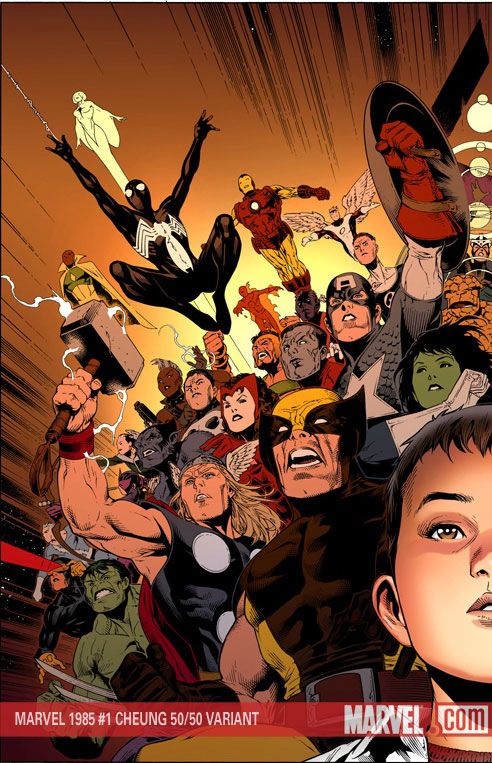"1985," or "Marvel 1985" if you want to be official, is a high-concept series first announced several years ago as a "photo comic," which would reputedly cost Marvel millions of dollars to make. Creator Mark Millar referred to it as potentially "Marvel's 'Narnia.'" Now, after years of delays, and a complete overhaul of the visuals -- giving Tommy Lee Edwards full reign to pencil, ink, and color the series in his own distinct style -- "1985" hits the stands to very little fanfare. In a late Spring filled with invasions, secrets, and crises, a strange little parallel universe series like "1985" might get lost amidst the Skrulls and dead gods. And that would be a shame, because Millar and Edwards have crafted a nice little series here, and in a week filled with great mainstream comics, "1985" was one of my favorites.
The premise is simple: in the year 1985, in a world like our own, the Marvel super-villains begin appearing. Someone has transported them from the Marvel Universe to our own, and they plan to take over this defenseless planet. I can see why the original concept involved photography, and as much as I despise every bit of fumetti I have seen, it might have been interesting to see what the Marvel characters would look like in our reality. In photographic reality, at least. I don't know why Marvel abandoned the plan, but my guess is that either the expense for quality photographic realism was too great or the audience too jaded; after all, if you've ever been to a comic convention, you know what the Marvel characters look like in our reality, and it's not a pretty picture.
Tommy Lee Edwards was certainly a better choice.
With Edwards, we get an artist who can draw realistic settings, expressive children, and menacing costumed-clad villains who look book threatening and ridiculous at the same time. All of those factors contribute to the quality of the visual narrative here, and while the photographic experiment might have been interesting, Edwards makes the comic good. Maybe even great. His expressive brushwork imbues each character with personality and manages to make the appearances of the Marvel characters seem surreal, rather than simply odd or corny. Edwards also adds a darkness and mystery to the series that's essential to the plot: are these characters really appearing, we wonder, or is it all in the boy's mind?
Mark Millar's script implies that it's really happening, the story of a young boy, a comic book fan -- and quite a different sort of comic fan from the one we see in "Kick-Ass" -- who's sneaking around in the dark with a flashlight, trying to see more of these mysterious costumed characters who have appeared in his neighborhood. The setting is 1985 for a reason: not only was it a more innocent time, for all of us 30-something comic book readers, and for the Marvel Universe as well, but it was also the age of Spielberg -- that cultural moment when "E.T." and "Indiana Jones" were the pinnacle of family entertainment. Millar's "1985" is very much like an 80s Spielberg film: it's Elliott from "E.T." meets Kurt Busiek and Alex Ross's "Marvels." And it works, almost completely.
One of the reasons "Marvels" was such a success, besides the painted artwork of Alex Ross, was that it helped to re-establish the strangeness and wonder of the Marvel characters. When they're punching each other, hanging out at their headquarters, or chasing Skrulls around, it's difficult to remember how fascinating each of these characters can be. "1985" reminds us, just as it reminds us of our own lost childhoods. But it doesn't shovel these things at us, cynically. It celebrates these lost moments, these pieces that we've forgotten. And I want to read more.

